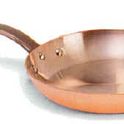How to make fried rice??
6 Comments
Madame H.May 22, 2014
Here are my secrets for the best fried rice:
Use only long-grain white rice. Jasmine rice is perfect because it is not too starchy and so cooks up into fluffy, individual grains. Short-grain rice mushes up easily, and brown rice is too heavy.
Cook the rice ahead of time and let it cool completely, which means at least to room temperature. This helps separate the grains even further so that you end up with very light fried rice.
Fry the rice in only a minimum of oil. This keeps the grains from getting soggy and heavy, and it also ensures that you taste the sweet flavor of the rice more than the oil.
Allow the other ingredients—both solids and seasonings—to blend in fully with the rice. Because the grains are fairly bland, use strong flavors that will not be washed out in this combination.
I also enjoy getting some toasty aromas in the rice, and so I give it a chance to brown in the oil. This Shanghainese touch makes some of the mouthfuls a bit crunchy while others are soft. (http://bit.ly/1lXy1Kj)
Use only long-grain white rice. Jasmine rice is perfect because it is not too starchy and so cooks up into fluffy, individual grains. Short-grain rice mushes up easily, and brown rice is too heavy.
Cook the rice ahead of time and let it cool completely, which means at least to room temperature. This helps separate the grains even further so that you end up with very light fried rice.
Fry the rice in only a minimum of oil. This keeps the grains from getting soggy and heavy, and it also ensures that you taste the sweet flavor of the rice more than the oil.
Allow the other ingredients—both solids and seasonings—to blend in fully with the rice. Because the grains are fairly bland, use strong flavors that will not be washed out in this combination.
I also enjoy getting some toasty aromas in the rice, and so I give it a chance to brown in the oil. This Shanghainese touch makes some of the mouthfuls a bit crunchy while others are soft. (http://bit.ly/1lXy1Kj)
PanfusineMay 22, 2014
I usually temper the seasonings (my favorite is cumin), Oil, cumin, couple of cardamoms, cloves a small piece of cinnamon & a bay leaf. once the spices bloom, add sliced onions, followed by any vegetables (shredded carrots, peas, beet, zucchini, roasted corn) or even crumbled Paneer (and any choice of spice blends, garam masala, Harissa, baharat, bere bere.. take your pick). Add the salt followed by the 'yesterday's rice directly from the fridge.fold to combine, sprinkle some water, cover and allow to warm up for about 10 mins on a low heat. Transfer to a serving dish, drizzle with lime or lemon juice and garnish with cilantro or dill.. Infinite possibilities!
bigpanMay 22, 2014
Sam has it down pat !
Gotta be day cold day old. Cover with Saran in fridge so the rice does not get overly dry. The right amount of soy sauce is key - start with a bit, stir, taste, repeat until you like it.
Gotta be day cold day old. Cover with Saran in fridge so the rice does not get overly dry. The right amount of soy sauce is key - start with a bit, stir, taste, repeat until you like it.
Taylor S.May 21, 2014
A fantastic resource: https://food52.com/blog...
trampledbygeeseMay 21, 2014
Oh I love - (big huge capital letters, four miles high) LOVE fried rice. Have it every other day.
It tastes great with leftover rice, but you can use fresh rice in a pinch. (Do be careful with leftover rice - it can be more deadly than raw chicken. http://www.bbc.com/news/magazine-25154046 Personally I never eat it after the third day, and only if I know it was stored right away and not left warm or at room temp. Reheating doesn't kill the nasties in it, so just be aware).
Step one: go spelunking in the fridge. What's in there? Carrots? Vegi? Leftover tofu or roast chicken (whichever floats your boat) or bbq fish? Maybe some sauce, spicy chili, or oyster, or one of my favorites kimchi and ketchup. Pre-cooked lentils are also fantastic in fried rice. Get out whatever combination makes you feel joyful.
Step two: chop, chop chop. Make everything small and easy to fry/chew.
Step three: Fry. Heat oil in pan, fry starting from the biggest or rawest thing first, like maybe carrots or bacon, whatever needs the most cooking... then add the next, then the next, until nothing left but the rice. Add the sauce, stir it well and cook a min or two. Don't be afraid to let the sugars in the sauce caramelize a bit.
Step four: add rice, stir it in, fry until well heated through, or longer if you like crunchy corners to your rice.
Step five: enjoy.
It tastes great with leftover rice, but you can use fresh rice in a pinch. (Do be careful with leftover rice - it can be more deadly than raw chicken. http://www.bbc.com/news/magazine-25154046 Personally I never eat it after the third day, and only if I know it was stored right away and not left warm or at room temp. Reheating doesn't kill the nasties in it, so just be aware).
Step one: go spelunking in the fridge. What's in there? Carrots? Vegi? Leftover tofu or roast chicken (whichever floats your boat) or bbq fish? Maybe some sauce, spicy chili, or oyster, or one of my favorites kimchi and ketchup. Pre-cooked lentils are also fantastic in fried rice. Get out whatever combination makes you feel joyful.
Step two: chop, chop chop. Make everything small and easy to fry/chew.
Step three: Fry. Heat oil in pan, fry starting from the biggest or rawest thing first, like maybe carrots or bacon, whatever needs the most cooking... then add the next, then the next, until nothing left but the rice. Add the sauce, stir it well and cook a min or two. Don't be afraid to let the sugars in the sauce caramelize a bit.
Step four: add rice, stir it in, fry until well heated through, or longer if you like crunchy corners to your rice.
Step five: enjoy.
Sam1148May 21, 2014
Start the day before. Fried rice is best used with cold rice.
When I use a skillet and electric stove I fry the harder veggies first (things like snow peas, onions, pepper, along with the ginger, garlic; and any meats I'm using like chicken or shrimp).
Then reserve that in a plate--add more oil to the pan and fry the rice a bit. Adding soy sauce at this point. Move the rice around to leave a little 'well' and add the eggs, if using eggs, and let them cook a bit...break them up after they've solidified and mix with the rice. Add back in the veggies and adjust seasoning with more soy sauce.
The key to fried rice is starting with cold leftover rice. Freshly cooked rice tends to turn out gummy and sticky.
If you have a high BTU stove and a wok...doing it in a couple of steps isn't needed. However the two step process gives much greater control to prevent overcooking and gummy rice.
When I use a skillet and electric stove I fry the harder veggies first (things like snow peas, onions, pepper, along with the ginger, garlic; and any meats I'm using like chicken or shrimp).
Then reserve that in a plate--add more oil to the pan and fry the rice a bit. Adding soy sauce at this point. Move the rice around to leave a little 'well' and add the eggs, if using eggs, and let them cook a bit...break them up after they've solidified and mix with the rice. Add back in the veggies and adjust seasoning with more soy sauce.
The key to fried rice is starting with cold leftover rice. Freshly cooked rice tends to turn out gummy and sticky.
If you have a high BTU stove and a wok...doing it in a couple of steps isn't needed. However the two step process gives much greater control to prevent overcooking and gummy rice.
Showing 6 out of 6 Comments
Recommended by Food52
Popular on Food52
Continue After Advertisement





